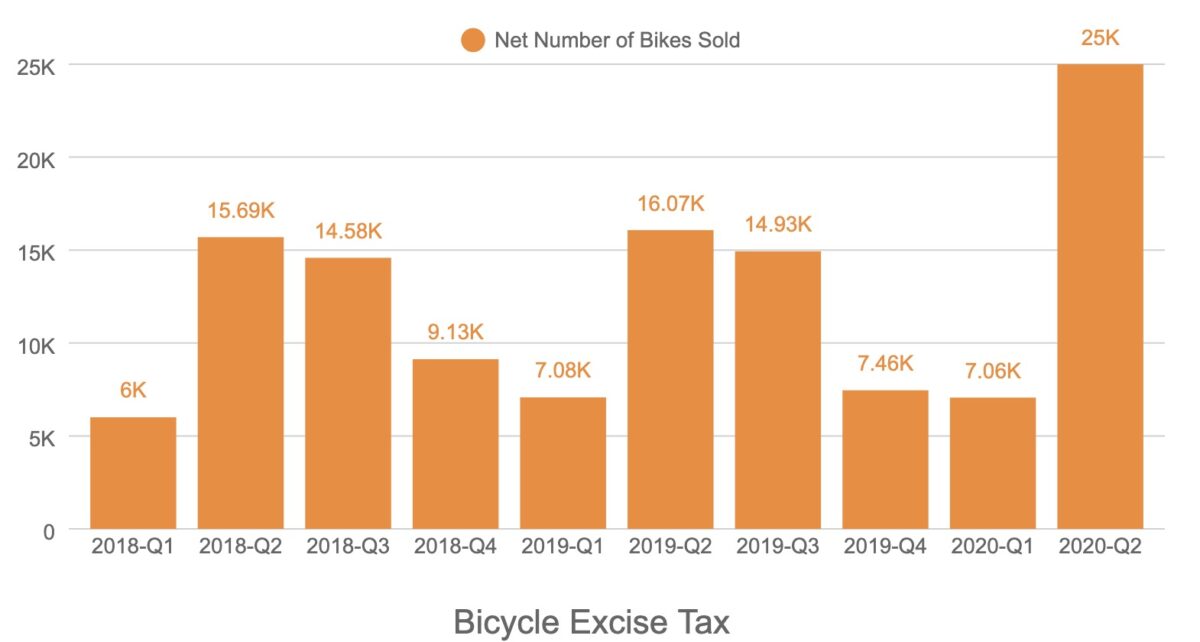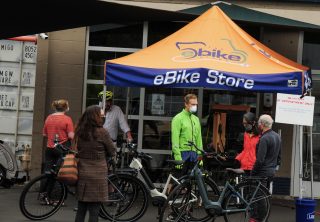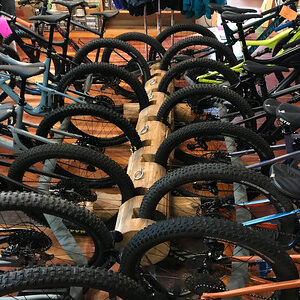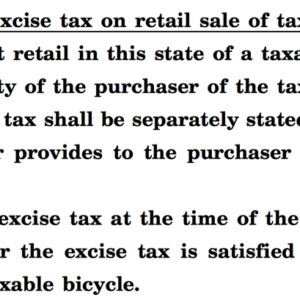
While most transportation-related revenue sources have been hit hard by the pandemic, there’s one seeing record highs.

(Photo: Jonathan Maus/BikePortland)
In a meeting of the Oregon Legislature’s Joint Committee on Transportation Wednesday, Daniel Porter, the chief economist for the Oregon Department of Transportation, told lawmakers the agency estimates a hit of about $170 million to the State Highway Fund for the 2020-2021 fiscal year. The transit tax passed in 2017 has suffered an 8% downward swing compared to last year and the new tax on new cars and trucks is down 10%.
But the bicycle excise tax? It’s way up.
With the bike boom hitting local shops in a very real way, we were curious how the explosion in bike sales would be reflected in Department of Revenue (DOR) statistics. Now we know: Porter said there’s been a 56% increase in bike sales between April and June of 2020 when compared to the same period in 2019.
According to their records (based on collection receipts from retailers) there were 16,073 new bicycles sold in Oregon in in the second quarter of 2019. This year there were 24,997. That’s by far the most recorded new bike sales since the state began collecting the tax in April 2018.
Advertisement
“In May, June, and July, we couldn’t build bikes fast enough.”
— Brad Parker, Metropolis Cycles
At $15 per bike, the tax has generated $480,900 through the first half of this year — almost as much as they collected for all 12 months of 2018. When the tax was passed in 2017, analysts estimated it would raise about $1 million per year. Porter says overhead and administrative costs to collect the tax have stabilized at about $3,250 per month. That means the tax has deposited roughly $461,400 into the Oregon Community Paths program.
Metropolis Cycles owner Brad Parker is on the front lines of this huge sales growth. He said business was “crazy” from May to July. “We couldn’t build bikes fast enough… It was like, holy cow!” Parker said sales in July 2020 were up 40% over 2019, and it was nearly all new bikes (service and repair revenues have been flat). Luckily he pre-ordered enough bikes to keep his inventory stable so the shop could capitalize on the spike in interest.
As for the $15 tax, Parker said he and his customers have adjusted to it. With a thick stack of receipts on his desk, Parker expects his next payment (due at the end of the month) will be considerable. And now that it’s been a few years, he said customers have come to accept it. When they first explained the tax to customers, Parker said some would whip out their phones to see if they were making it up. But now, “I’d say only one out of 50 asks for a $15 discount, but you always have people asking for discounts.”
Overall, Parker is happy to be selling so many new bikes — especially because most of them are going to novice, first-time buyers or people who are just getting back into cycling after a long hiatus. And he’s looking forward to fall. “We stocked up on tons of fenders, because we sold tons of bikes without them,” he said.
— Jonathan Maus: (503) 706-8804, @jonathan_maus on Twitter and jonathan@bikeportland.org
— Get our headlines delivered to your inbox.
— Support this independent community media outlet with a one-time contribution or monthly subscription.






Thanks for reading.
BikePortland has served this community with independent community journalism since 2005. We rely on subscriptions from readers like you to survive. Your financial support is vital in keeping this valuable resource alive and well.
Please subscribe today to strengthen and expand our work.
Okay, so now they can track bike sales accurately. They can see more bike infrastructure is needed. Nuff said.
Absolutely! This is exactly when PBOT and ODOT (and all other acronyms) need to double down and build connected, safe mobility infrastructure to achieve climate and equity goals. There’s no use in having people with bikes and roads that are hostile to their existence.
“Bike infrastructure” for ODOT just means “self-cleaning breakdown shoulder”.
“Wiggle room for trucks” is how NCDOT puts it.
The struggle is real. After the first real rain, Barbur is a mess.
If by “self cleaning” you mean “cleaned by the cyclist that nearly got killed by entering the car lane to avoid debris”, than yes.
“self-cleaning” is the terminology ODOT uses when you ask them to clean gravel out of the bike lanes on their facilities. I guess they believe that rain/wind will move 3/4 minus gravel off of a breakdown shoulder/bike lane. Any shoulder with a ditch is considered “self-cleaning”.
Actually “self-cleaning” refers to any street or road, guttered or gutterless, whereby car traffic regularly moves over towards the right curb (especially at night and/or in bad weather) and gradually shifts the debris further right into the gutter or ditch, largely eliminating the need for frequent street sweeper services. A painted bike lane doesn’t inhibit this process very much, as most drivers ignore the lanes at night, but a barrier-protected bike lane does block this process.
It’s not that simple.
If I am buying a 3rd bike (or car), then I do not require any additional infrastructure to get the same utility I had before.
If I live in the center city, then I likely do not need any additional infrastructure in east county as I am not served by additional capacity.
Existing infrastructure capacity may be sufficient to absorb an uptick in demand. Bike lanes are almost never congested end to end for hours a day – so there is PLENTY of capacity for demand.
If you are suggesting *new* or enhanced infrastructure in currently underserved places then you are getting somewhere but then you’d have to prove there is a demand for it there.
It all depends who is buying what and where is it being used. And that all depends on the model we are using – do we build more where/when it is needed or do we build capacity whether or not it is needed.
“In a meeting of the Oregon Legislature’s Joint Committee on Transportation Wednesday, Daniel Porter, the chief economist for the Oregon Department of Transportation, told lawmakers the agency estimates a hit of about $170 million to the State Highway Fund for the 2020-2021 fiscal year. The transit tax passed in 2017 has suffered an 8% downward swing compared to last year and the new tax on new cars and trucks is down 10%.”
Bikes up, cars down.
Or “travel demand down”. You need to state whether or not bike travel is up to make that statement. Not bike ownership – bike travel. Anecdotally (like Reddit), I saw a lot fewer riders during the first few months of the pandemic on the bikeway I live on.
Let us know when you’ve completed your bike and vehicle counts on all major corridors.
You first – were the one suggesting bikes were up. Prove it – you only listed tax revenues – which is not travel demand. Tax revenue could be down but travel the same (people just not buying new cars).
The sales data is sufficient. You can prove otherwise.
You are correct – it is insufficient. So stating more infrastructure should be built based upon the data is a simplistic and incorrect statement.
Ugh. Stating more infrastructure should be built based on uptick in bike sales is beside the point. Your basic premise that current infrastructure is “sufficient” is the more suspect idea based on vehicular cycling ideology. We rarely wait for people to risk showing up on a road to justify building sidewalks. Having a few metal tubes and rubber circles accompanying you doesn’t make that any safer.
We should definitely test this theory. Remove roads and find out how much demand for cars there is by counting the cars.
Correct statement would be new cars down used car sales, bicycle sales, dirt toys (motorcycles, ATVs and UTVs) and boat sales have increased this year.
To be blunt, all you need to do is go to any Reddit cycling forum and on a daily basis there are posts like, “looking for first bike in 20 years, but all sold out”.
The bike market has been exhausted to the point that 70 year old, spit polished, rust bomb bicycles are offered up for $350. So, you can say that the sales are to people with 3 cars and 3 bikes, but it’s a false claim that you can’t substantiate.
So why can’t I sell my (not rusty) Bridgestone 400? Oh yeah, 19″ frame and newbies can’t imagine a bike they try with different handlebars.
If you are truly failing to sell a bike, you haven’t been going about it effectively. There are plenty of people looking for a bike. Let me know if you’d like some advice on reaching your target demographic.
Along the line of false claims, you can’t prove those bikes are being used – just that they are being purchased…creating less inventory. The data on new bike purchases would be more useful if it told us how many bikes people already own – which is why I said “if”.
Could be like the toilet paper situation – buying something because it seems like a good idea and everyone else is doing it but not actually needing it.
But you’ve not addressed the comment about needing more infrastructure. We don’t build more infrastructure just because car sales go up.
Buying $50 in TP does not equate to buying $1500 in bicycle.
It’s true that bike sales do not directly correlate to new ridership. However, I think it’s dishonest to suggest that increase in bike sales does not carry over to increase in bike ridership.
Also dishonest, undercutting “increased ridership and increased sales are related” to prop up the argument “bikes being sold are bought as additional bikes”.
In short, I find your arguments circumspect and I question your motives for positing such slanted statements.
He just wants an argument.
Ahh yes, Try Mr. Barnard; room 12.
Yep, the “middle of the road driver” schtick. Ignore him, and hopefully he’ll go away.
“I came in here for an argument”
“No you didn’t”
“Yes I did”
“No you didn’t”
It all depends on whether you use it or not.
You can say it is dishonest – I am just asking for proof. Buying more toilet paper does not mean more people are taking dumps – and every new bike I buy does not end up in increased ridership.
But rather than going down a tangent, I am asking your reply in how an uptick in bike sales automatically translates into a need for new infrastructure. A slanted statement in itself 🙂
Your argument is built on a fallacy: false equivalency. Your claim for evidence is invalidated as your argument doesn’t belong in play.
You won’t answer my question and your initial statement is the issue. You know this, which is why you will not answer.
I’m scanning your comments for punctuation that indicates you are asking a question. I do not see a question mark, so no question was asked.
You even demonstrate a firm grasp of this concept by saying,
You called it a comment, not a question. I think, deep down, you know what I’m saying here. Do you?
Here is your flimsy entry into the conversation. You clearly base your entire argument on the statement that bike purchases are “spare” or additional bikes. Not first time bike buyers.
Can you substantiate that claim?
There are multiple reasons for the pandemic bicycle boom.
Outside Bicycle Habitat in Brooklyn, the line of customers waiting to buy new bikes or have old ones repaired stretches down the block nearly every day. While bike sales usually increase in warmer months, the recent flood of customers is unheard of, the owner, Charlie McCorkell, said.
Yes, there are few people biking because there is no separated infrastructure. Just like there would be no people walking if there were no sidewalks.
Like the way no one walks on Powell out towards Gresham?
Not sure what you mean. Where the Outer Powell Trans Safety project is?
I mean lots of people walk on Powell where there are no sidewalks.
Absolutely true. Even on incredibly dangerous situations, people will make due with what they have.
Yes, between 97th and 174th; lots of pedestrians, mothers with strollers, dog walkers, but very few sidewalks, so folks have to walk in the painted bike lane, no choice really. Lots of deaths over the years, of course. Side streets are even worse, many are gravel.
Maybe people who don’t ever bike are buying up new bikes to keep them off the road. That would mean the more new bikes bought, the less likely it will be that there will be new bikers, so we shouldn’t build ANY new infrastructure. That MIGHT be what’s happening.
I recently bought into a consortium buying bikes as a cheap way to stockpile base metals under the presumption that prices will rise as climate-related restrictions kick in.
One of our storage depots
It’s clearly a Deep State communist plot in opposition of our Christian ideals of a SRAM 930 chain in every rice bowl.
You forgot the closing /s tag.
Good news for bike thieves as well. Lock those new rides people. Peace.
Re: “According to their records (based on collection receipts from retailers) there were 16,073 new bicycles sold in Oregon in in the second quarter of 2019. This year there were 24,997”
I believe that only includes bikes which are taxed, right? There are also a large number of kids bikes and low-price bikes (mostly sold at discount stores) which are not taxed, and I expect that they are not included in these figures.
“The tax is applied to the purchase of each new bicycle that meets all of the following criteria:
– Is exclusively human powered or is electric-assisted;
– Is new or not previously owned by a consumer;
– The retail sales price is $200 or more.”
https://www.oregon.gov/dor/programs/businesses/Pages/Bicycle-excise-tax.aspx
Yes. Figures only include taxed bicycles.
Does it include mail-order bikes and those smuggled over the border?
Nope…you should see all the white painted over uhauls parked at the north bridgehead of the Interstate Bridge with bike touts trying to sell bikes to folks riding to Portland. 😉
Actually there are probably more lost sales to Vancouverites buying in Portland than Portlanders buying in Vancouver due to the combined issue of sales tax and wider selection (~3 shops vs 60+ LBS.)
Yeah, when I bought my Surly Bridge Club frame set last January for $500, I paid 4.75% ($23.75) to North Carolina and 2% ($10) to Greensboro to build freeways, $33.75 in sales tax altogether. I’m so jealous that you folks in Oregon only pay a $15 flat fee.
Oregon has 10% income tax vs. 5% in North Carolina. I think you are doing okay down there, tax-wise.
No, actually I calculated it one year and found it was roughly the same – my income tax is very low in NC, true, but I was paying over $1,000 in sales taxes annually. The state sales tax of 4.75% is on all goods and some services, while the local 2% sales tax is on everything, including staple foods (milk, bread, flour, veggies, etc.)
I ordered a bike online last year from out of state and did not have to pay the $15 tax.
Somehow cities need to figure out a legal way to tax online purchases. Local businesses have to support all the local infrastructure with taxes and business fees while on-line merchants often escape many of those taxes and fees and don’t pay a fair share of the costs to support cities where their products are delivered.
This is typically done with a sales tax. Amazon, for example, charges sales taxes in states that have them.
Good luck implementing one here — it would help the state immeasurably, but if there’s one issue that unites Oregonians across the political spectrum, it’s “no sales tax!”
Besides, Amazon doesn’t “operate” here (well, actually they do, and they pay whatever taxes/fees/licenses/etc. that the city requires for their facilities). But if Amazon is just mailing packages, it’s UPS/FedEx/etc. that are doing the “operating”.
The out-of-state-sales-tax rule was ruled unconstitutional by the US Supreme Court a few years ago, and most online retailers have been gradually getting more compliant about charging appropriate sales taxes of people doing the ordering, even and especially when the online retailer doesn’t do business locally (as most do not.) As usual, it’s a matter of enforcement, rather than of the law. Usually the only way for us to avoid the sales tax is to live in a state without one (5-6 minor states including Oregon) or order from an overseas retailer and try to avoid their 21% VAT (but incur credit card and exchange charges.) Online retailers from any place are now very good about charging even obscure local city sales taxes, most likely through their credit card vendor. If you order online with an Oregon ship-to address from a NY, CA or NC retailer, you’ll pay no sales tax; but if I order from an Oregon retailer and ship to NC, I will be charged applicable NC and local sales taxes. However, the $15 Oregon fee is a fee, not a tax, so it’s up to the state of Oregon to collect it, but not other states or cities.
If I somehow end up avoiding paying a sales tax charge along the way, my NC income tax form has a special section for me to declare any missing charges. Like everyone else, I check the box that says I swear I’ve paid all my sales taxes (whether that’s true or not). (FYI, NC charges no income tax for my first $10,000 income, and a 5.25% flat rate for the remainder.)
I’d prefer to see some tightening of the belt by the state before they even think about more taxes. We have one of the highest income taxes in the nation at 9%, very high property taxes, and it just cost me over $200 to smog check and license my $1,500 car! We don’t need more taxes. We need the government to stop wasting the taxes they collect, to stop promising gold-plated pensions that noone but CEOs get in the private sector, etc. Fiscal responsibility.
Wow, great news on increased bike sales. At this rate bikes (through the purchase tax) will pay more in to the transportation fund than EV’s.
Oregon pays people to buy EV’s, up to $2,500 per new vehicle purchase!
Both EV’s and bikes have contradicting incentives and surcharges. The bicycle bill is contradicted by the sales tax while the EV rebate is contradicted by the significantly higher registration cost. It’s almost as if politicians want to satisfy all special interest lobbies at the same time regardless of impact on society and the environment.
This probably means cheap used bikes for sale once people resume driving after the pandemic
Yep, once those “Christmas puppies” get a little older, they will be offed for cheap.
I hope you’re right, I’d like to get in on this newfangled gravel bike fad I’ve been hearing about. Unfortunately, I think it’s a little more likely that they just sit in garages for the next several decades.
Well, there’s no way of knowing for sure. I made an intentionally glib statement. I hope it turns out to be a wrong prediction. I would enjoy nothing more than to see a permanent increase daily cyclists, as a legacy from COVID-19.
Either way, I hope they don’t sit in disuse.
I’d like to thank President Trump for my $1200 stimulus check signed by President Trump. I’ll bet a lot of those went to new bikes. 😉 FYI, Donald Trump used to run a bike race on the east coast. He was into biking before many reading this were born:
https://www.politico.com/magazine/story/2016/04/donald-trump-2016-tour-de-trump-bike-race-213801
That’s what I did. Ended up buying a bike and some accessories out of state (screw that bike tax!). So, thank you President Trump!
“into biking” ha ha.
From that article:
“It doesn’t appear that Trump’s foray into cycling had a big effect on the candidate, though. At a rally last fall, two weeks after Secretary of State John Kerry broke his leg biking outside Geneva, Trump made a solemn campaign pledge: “I promise I will never be in a bicycle race. That I can tell you.””
So yeah another tax program where the ODOT administration fees get bloated, the projected numbers where too high, and revenue from the tax is so paltry that this flat, regressive tax is not an equity tool. But it is a handy data collection point.
I expect the same program fee trajectory for congestion pricing. ODOT is going to wiggle its administrative fingers into the funding pot to pay for PERS. Its a vicious union cycle at AFSCME; climate denial-ism, no GHG emissions reductions mission, and a bunch of over payed engineers earthquake proofing bridges till they make it to retirement.
NO CHANGE REQUESTS ALLOWED
Over here in Bend an electric-only shop just opened and the owner said his sales are through the roof. He does scooters boards and even unicycles as well. It is in an upscale neighborhood. Consistent with what I see out on the roads. A higher and higher proportion of bikes are e-bikes, sometimes 20 miles out of town. I am still constitutionally opposed to them (retrogrouch former racer), but they are obviously here to stay.